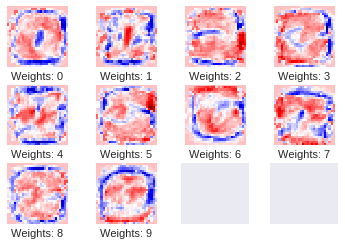logistic regression to recognizance handwritten numbers
Overview
This is a quick example on how to a neuron performs classifying hand reading digits You can download or run this code from here
Download data
The first thing you want to do is to download your data.MIST comes pre-loaded with TensorFlow, you can download it suing the following command
from tensorflow.examples.tutorials.mnist import input_data
mnist = input_data.read_data_sets("MNIST_data/", reshape=False)
X_train, y_train = mnist.train.images, mnist.train.labels
X_validation, y_validation = mnist.validation.images, mnist.validation.labels
X_test, y_test = mnist.test.images, mnist.test.labels
Visualize data
Finding out the size of your data, how it looks, and image dimensions can help you know what type of ML algorithms to use and what type of postprocessing is needed.
import random
import matplotlib.pyplot as plt
import numpy as np
%matplotlib inline
index = random.randint(0, len(X_train))
image = X_train[index].squeeze()
plt.figure(figsize=(1,1))
plt.imshow(image, cmap="gray")
print("label for this image: {}".format(y_train[index]))
img_shape = (X_train[0].shape[0], X_train[0].shape[1])
img_size_flat = (img_shape[0] * img_shape[1])
print ("image size {}" .format(img_size_flat))
num_classes = len(np.unique(y_train))
print(num_classes)

Tensorflow basics:
A placeholder is a variable that we can use to transfer a value when we run our Tensorflow session. It creates a memory space for variables that will be using in the future. In this case x stands for our images and y for our labels
Logits is a matrix with an estimate number of how likely the input image is to be of the a class. In order for this number to look like a provability we have to normalize them (zero to one) using softmax.
Architecture
import tensorflow as tf
from tensorflow.contrib.layers import flatten
tf.reset_default_graph()
#Placeholder variables
x = tf.placeholder(tf.float32, (None, img_shape[0], img_shape[1], 1))
y = tf.placeholder(tf.int32, (None))
weights = tf.Variable(tf.zeros([img_size_flat, num_classes]))
biases = tf.Variable(tf.zeros([num_classes]))
def model(x):
fc = flatten(x)
logits = tf.matmul(fc, weights) + biases
return logits
Training Graph
EPOCHS = 20
BATCH_SIZE = 128
rate = 0.001
one_hot_y = tf.one_hot(y, num_classes)
# Get logits
logits = model(x)
y_pred = tf.nn.softmax(logits)
y_pred_cls = tf.argmax(y_pred, axis=1)
# Computes softmax cross entropy between logits and labels
cross_entropy = tf.nn.softmax_cross_entropy_with_logits(labels=one_hot_y, logits=logits)
#Calculate loss
loss_operation = tf.reduce_mean(cross_entropy)
optimizer = tf.train.AdamOptimizer(learning_rate = rate)
training_operation = optimizer.minimize(loss_operation)
Validation Graph
correct_prediction = tf.equal(tf.argmax(logits, 1), tf.argmax(one_hot_y, 1))
accuracy_operation = tf.reduce_mean(tf.cast(correct_prediction, tf.float32))
def evaluate(X_data, y_data, sess):
num_examples = len(X_data)
total_accuracy = 0
#sess = tf.get_default_session()
for offset in range(0, num_examples, BATCH_SIZE):
batch_x, batch_y = X_data[offset:offset+BATCH_SIZE], y_data[offset:offset+BATCH_SIZE]
accuracy = sess.run(accuracy_operation, feed_dict={x: batch_x, y: batch_y})
total_accuracy += (accuracy * len(batch_x))
return total_accuracy / num_examples
Start tensorflow training session
import time
sess = tf.Session(config=tf.ConfigProto(log_device_placement=True))
sess.run(tf.global_variables_initializer())
def train():
beginTime = time.time()
for offset in range(0, len(X_train), BATCH_SIZE):
end = offset + BATCH_SIZE
batch_x, batch_y = X_train[offset:end], y_train[offset:end]
sess.run(training_operation, feed_dict={x: batch_x, y: batch_y})
validation_accuracy = evaluate(X_validation, y_validation, sess)
endTime = time.time()
print ("Total time {:5.2f}s accuracy:{}".format(endTime - beginTime, validation_accuracy))
Start tensorflow training session
for i in range (15):
train()
plot_weights()
Output:
Total time 0.46s accuracy:0.9104
Total time 0.45s accuracy:0.9158
Total time 0.44s accuracy:0.9184
Total time 0.45s accuracy:0.9204
Total time 0.50s accuracy:0.9226
Total time 0.51s accuracy:0.924
Total time 0.51s accuracy:0.9248
Total time 0.50s accuracy:0.9264
Total time 0.51s accuracy:0.926
Total time 0.54s accuracy:0.926
Total time 0.49s accuracy:0.9264
Total time 0.50s accuracy:0.9274
Total time 0.49s accuracy:0.9278
Total time 0.49s accuracy:0.929
Total time 0.51s accuracy:0.9294
-1.6156687
1.2737342
Conclusion
With out suing any sophisticated architectures, a single neuron net was able to get 93% accuracy at MINST dataset.

Reference
Download or run this code from here
